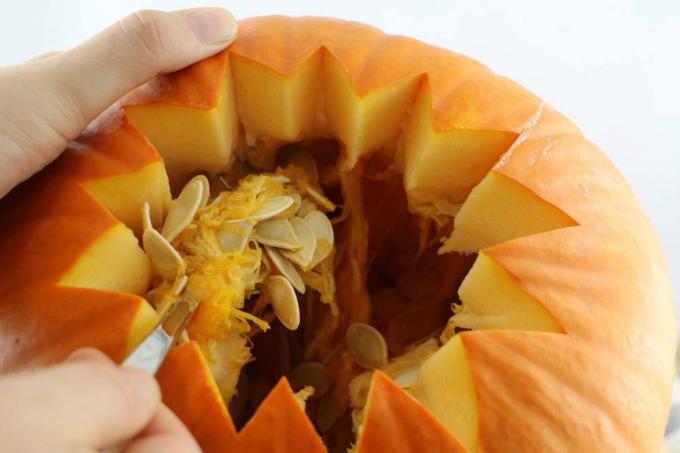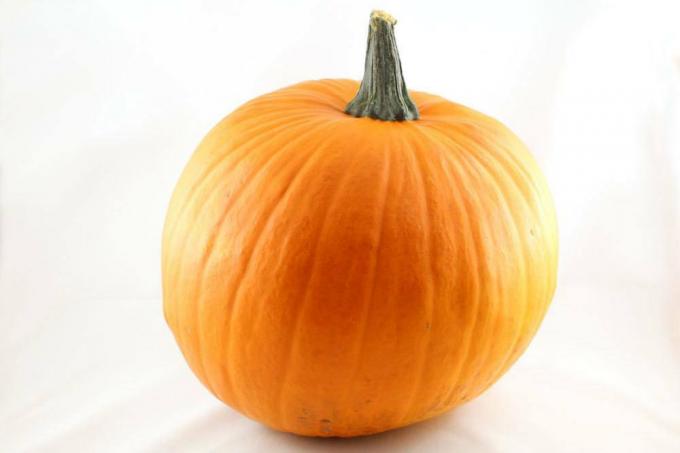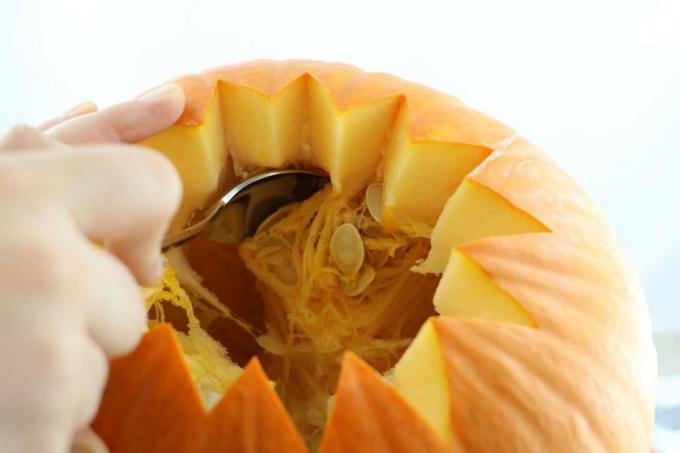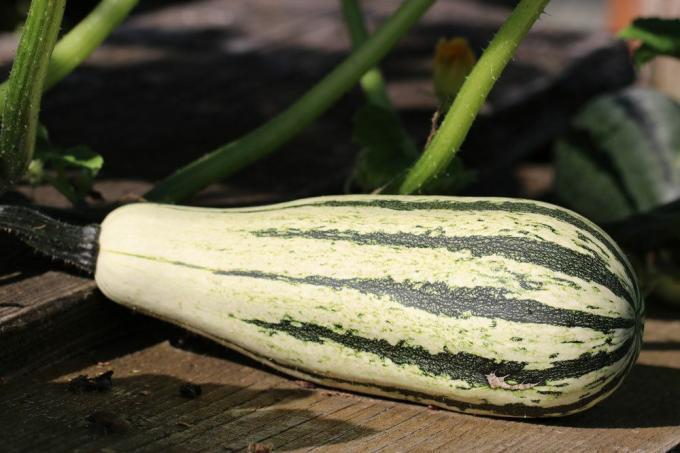
table of contents
- Ornamental Pumpkins
- harvest
- Preserve
- dry
- Pumpkins
- Preserve
- Freeze
- Raw
- Cooked
- To store
Pumpkins come in a wide variety of shapes, colors and sizes. A distinction is made between decorative and edible pumpkins. Probably the best known of them is that Hokkaido pumpkin, which is both an ornamental pumpkin and a table pumpkin, especially on Halloween. Unfortunately, at some point they start to go moldy and have to be disposed of. However, there is one or the other or method to make them durable for a short or longer period of time. The type of preservation depends on the type of pumpkin.
Ornamental Pumpkins
harvest
Harvest at the right time
In order to be able to preserve ornamental pumpkins, they must first be harvested at the right time. You can recognize a ripe pumpkin by the fact that the skin is hard and the style is lignified. The pressure test can provide information about the degree of maturity. As soon as the peel no longer yields to pressure, it is ready for harvest. The firmer and thicker the skin of a pumpkin, the better it is suitable for preservation. As a rule, they should be harvested as late as possible, but still before the first frost. Preferably on a sunny day around noon.
At least as important is the fact that you should only use fresh and completely intact pumpkins. Specimens that have pressure points, soft spots, cracks or holes are not suitable for conservation. Germs can penetrate such damaged areas, which promotes decay and significantly reduces the shelf life. Smaller and thin-skinned decorative pumpkins can usually only be preserved for a short time.

Preserve
Preserving decorative pumpkins
Pumpkins are not only extremely decorative for Halloween. Actually, they shouldn't be missing in any autumn decoration. However, they do not last forever, which is in the nature of things when it comes to organic material in connection with water. Because the moisture in particular is responsible for the rapid deterioration. If you want to counteract this and extend the shelf life of these pretty fruits, there are different ways of preserving them. However, successful conservation requires a few basic things and begins with the right harvest time.

Short-term preservation
For a short-term preservation, the use of hairspray and / or clear lacquer is recommended. The moisture is locked in, the pumpkin stays crunchy a little longer and does not lose its size. The main thing is to spray the inside of the pumpkin over and over again. This means that the pumpkin has to be hollowed out first. Then it can be sprayed with hairspray or varnish. However, this type of preservation does not protect against mold growth. After this treatment, they can be kept for between 7 and 12 days longer.
Tip: If you rub the outside of the pumpkins with beeswax or floor wax, they also get a nice shine.
Making carved works durable
When people talk about carved pumpkins, the typical orange Halloween pumpkin comes to mind. With a few small aids, its shelf life can be significantly extended. But before it can be preserved, the shell must be carefully cleaned. Then the lid can be cut off and the pulp completely removed or the pumpkin will be hollowed out. Only clean and sharp cutting tools should be used for cutting. Care must be taken to avoid damaging the shell, which could later be a gateway for bacteria.

- soak whole pumpkin in a bleach solution after scooping out
- Make a solution from 5 ml of bleach and 4 liters of water
- soak for at least an hour
- Pumpkin is said to absorb water, which makes it firmer and plumper
- this protects it from dehydration for longer
- Treatment with bleach, superficially kills most microorganisms
- it delays the process of decay
- then dry the fruiting body thoroughly, both inside and out
- Any remaining moisture inside can accelerate the rotting process
- In the next step, spray the pumpkin inside and out with a stronger bleach solution
- Now make the solution from 15 ml of bleach and 1 liter of water
- then dry the pumpkin well inside and outside with a clean cloth
- Allow to air dry for at least 20 minutes
- do not let dry longer than an hour

Now the pumpkin including the cut areas is rubbed with petroleum jelly. However, you should only do this if you have treated it with bleach beforehand. Otherwise, you lock in the microorganisms with the petroleum jelly, which in turn accelerates the rotting process. Vegetable oils can also be used as an alternative to petroleum jelly. For visual reasons, you should then remove excess Vaseline with a clean cloth. Now it is a matter of keeping the pumpkin in a cool and damp place out of direct sunlight. to store.
Tip: Instead of bleach, you can use a commercially available pumpkin protectant, which is usually available in hardware stores or anywhere you can buy pumpkins.
dry
Dry whole decorative pumpkins
While carved pumpkins need moisture for preservation, whole ornamental pumpkins need to be dried. It is particularly important that the pumpkins dry out slowly. We do not recommend drying in the oven or on the heater. Here the water would be withdrawn from the pumpkins too quickly, causing them to shrink. That's why it's best to air dry them.

On the field
With this method, the ripe pumpkins are simply left to dry on the shoots of the plants in the field. When the pumpkin plant slowly withers with the onset of the cold temperatures, the fruit separates from the tendril and begins to dry up. The best thing to do is to lay them on a dry bed of straw at an early stage to prevent them from lying on the wet soil, which in turn encourages rot. From time to time the degree of dryness can be checked by lifting the fruit, tapping or shaking it.

A dry pumpkin is much lighter, it has lost quite a bit of weight. A hollow noise should be heard during the knock test, which indicates full maturity. If you shake a dry pumpkin, you can usually hear the rattle of the seeds. When the pumpkins are completely dry, they can be collected and stored accordingly. Here, too, only intact fruits should be used for storage and damaged fruits should be disposed of.
In a storage room
If you don't want to let the pumpkins dry in the field, you can cut them from the tendrils as soon as they are fully ripe and the leaves of the pumpkin plant have turned brown. A small stalk at least 3 cm long should always remain on the pumpkin. The pumpkin can evaporate water more quickly via the interface on the stem, which speeds up the drying process somewhat.
- After harvesting, clean the pumpkins with lukewarm soapy water
- then dry off well
- Wet the outside of the pumpkin with rubbing alcohol to protect it from fungi and bacteria
- it should not be too damp or even wet afterwards
- too much moisture would build up again in the fruit
- the alcohol could damage the fruiting body
- now lay out pumpkins to dry
- Place them next to each other on a wooden shelf with sufficient space between them
- Fruits should be well ventilated on all sides at all times

The storage place should be in a warm and dark room. It is advisable to turn the pumpkins about once every two weeks so that they can dry evenly all around. Depending on the size of the fruit, it can take between six months and a year for the pumpkins to be completely dry. The dried fruits can then be coated with a layer of wax (wax paste) to seal the surface and additionally protect it from bacteria.
Tip: If the number of pumpkins to be dried is rather small, they can also be dried hanging on the stems. You simply tie a thick ribbon around the stems and hang them to dry.
Pumpkins
Preserve
The type of preservation or Preservation depends on the type of pumpkin and what you want to preserve it for. They can be stored in the refrigerator for a short time or frozen for longer storage. But not every pumpkin is also suitable for consumption. There are pumpkins that are used exclusively for decoration or are grown for decorative purposes and are also poisonous. In contrast to edible pumpkins, which have an aromatic to sweet taste, ornamental pumpkins contain bitter substances (cucurbitacin). It is best to buy pumpkins directly from the producer so that you can eat them without worry and preserve them accordingly.

Freeze
Freezing is the easiest way to preserve pumpkins for later consumption, both raw and cooked. Only fully ripe pumpkins and varieties of good quality should be used for this. Pumpkin varieties with dry or very fibrous pulp are less suitable. For example, the Hokkaido is not only suitable for carving a Halloween grimace, but also excellent for freezing. First, the fruits are cleaned under running water. Soap should not be used to clean pumpkins intended for consumption. Rough dirt can be easily removed with a vegetable brush.
Raw
If a Hokkaido is to be frozen raw, it does not have to be peeled, but only removed from its core. All other edible pumpkins must be peeled, pitted and the stem removed. Then they are cut into bite-sized pieces, filled in portions into freezer bags and frozen.

Cooked
In addition to the raw version, the fruits can also first be cooked to pulp and then frozen. To do this, put the finely chopped pulp in a saucepan, where it is steamed for about 20 minutes. As soon as it has a soft consistency, pour off the water and chop it up with a hand blender. Then the puree is left to cool well and filled into suitable containers for freezing. The puree can be frozen for several months.
Tip: Under no circumstances should the cores be disposed of. Roasted they are a real delicacy and also very healthy.
To store
Store pumpkins properly
Freshly harvested pumpkins such as Hokkaido, nutmeg squash or butternut can be kept for several weeks, sometimes even months, if stored correctly. This assumes optimal conditions during storage. This should be done in an airy, dry and cool place at temperatures around 12 degrees, for example in a frost-free garage or a well-ventilated unheated cellar. Pressure points should be avoided, they quickly soften and start to rot. Fruits that have already been cut can be kept in the refrigerator for around two days.



